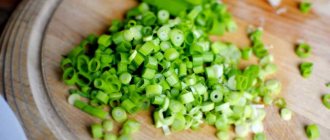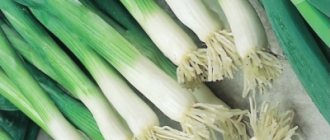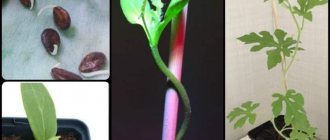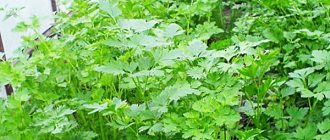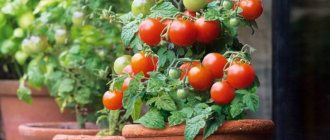Parsley varieties for growing on a windowsill
Growing parsley at home occurs under not entirely favorable conditions - insufficient humidity and low light. Therefore, not every planting material is suitable for growing parsley from seeds on a windowsill. Early ripening varieties are the most suitable.
Which parsley do you prefer, leaf or curly?
LeafyCurly
Breeders, taking into account the interest in vegetable gardens on windowsills, have developed a number of varieties that make it possible to successfully grow parsley on a windowsill:
| Leafy | “Morning freshness”, “Ordinary leaf”, “Gloria”, “Beads”, “Russian feast”, “Fitness”, “Prima”, “Emerald lace”, “Appetizing”, “Universal”, “Italian hero”. |
| Curly | “Astra”, “Fragrant Alley”, “Green Pearl”, “Vorozheya”, “Grandma’s Garden Bed”, “Curly Sue”, “Petra”, “Curly”. |
Helpful information
Daria Vorontsova
Amateur gardener. He is interested in growing various greens at home.
Curly parsley has a less pronounced taste and aroma, but, having an unusual foliage shape, is great for decorating salads and other dishes.
All of these varieties are united by early ripening, which allows you to use tasty and healthy fresh greens all year round.
Vorozheya
This variety is classified as curly; it has medium-sized corrugated leaves and a short petiole. Parsley looks great and is therefore often used for decoration.
Her greens are fragrant due to the high content of essential oils.
To get a good harvest on the windowsill, the plant needs to be illuminated. Phytolamps or LED lamps are suitable for this. Daylight hours should be at least 12 hours.
Features of growing parsley on a window
When choosing a method for growing parsley on a windowsill, you should take into account that sowing seeds is a longer process, allowing you to get the first harvest 1.5-2 months after sowing. The advantage of this method is the ability to obtain fresh herbs for a long time.
Planting with root vegetables is an easier way. The harvest can be used much earlier. In addition, there is confidence in the variety of parsley, while when sowing seeds you can only rely on the inscription on the bag. The disadvantage is that the soil is quickly depleted and it becomes necessary to replace it or replant the plant in a new pot.
Helpful information
Daria Vorontsova
Amateur gardener. He is interested in growing various greens at home.
One of the prerequisites for growing parsley from seeds is thinning out the seedlings. The interval between them should be at least 3-4 cm. Root crops can be planted in a pot almost close to each other.
With any method, drying out of the soil is unacceptable. Excess water from the pan must be drained. After watering, to avoid the appearance of a dense crust, the soil should be loosened. It is recommended to cut off not the first sprouts that appear, but to wait until the plant has strengthened. If you want to grow parsley all year round, in summer in good weather you can move it to the balcony.
How to care at home
Caring for parsley growing in a pot is not difficult if you know its basic requirements!
Lighting
Parsley grows best in a sunny, preferably south-facing windowsill where it can receive six to eight hours of direct sunlight each day. If your window is not so bright or the weather is often cloudy, you will have to supplement it with fluorescent lighting.
Rotate the pot every three to four days so that the plant does not pull to one side and grows evenly and symmetrically.
Watering
The soil of homemade parsley should be sufficiently moist. As soon as plants grown from seeds reach a height of 1-1.5 cm, do not water them from above, but pour water into the tray on which the pot stands. Do this only once a week unless the ground seems very dry.
This plant loves moisture from a spray bottle.
In summer, watering should be more abundant than in winter.
Temperature
The optimal temperature in the room where parsley is grown should be 16-24 C.
Fertilizer
There is no need to use fertilizers if you use purchased soil - it is already enriched with organic substances. However, you can use an all-purpose liquid fertilizer every two weeks if your parsley is not growing well.
Trimming
Remove flower stems as they appear to encourage green growth. Trim away dead and yellowed leaves from time to time to keep your plant in shape.
Pests and diseases
Leaf spot and root rot are some of the most common diseases. You will keep your parsley healthy if you avoid making the soil waterlogged due to overwatering.
Parsley may have aphids and spider mites, so inspect the plant carefully. If these pests appear, wash the foliage with soap and water.
Growing parsley from seeds
Step-by-step algorithm for growing from seeds:
- Wet the seeds and leave to germinate for several days;
- Place drainage at the bottom of the container;
- Pour the soil mixture on top and lightly moisten it;
- Make grooves in the ground no more than 0.5 centimeters deep;
- Sow seeds in the furrows and sprinkle with a small amount of soil;
- Moisten the soil with a spray bottle;
- Place the container in a warm place;
- Water regularly with warm water;
- Thin out the first shoots and place the container on the windowsill;
- Provide additional lighting;
- Start harvesting.
The process of growing from seeds is quite long. From sowing to harvest it takes about one and a half months. Another growing option is hydroponics. With this technology, the seeds are placed directly into a special substrate.
Preparing the seeds for planting
Parsley seeds are soaked in essential oils - this factor affects the speed of “hipping”. If sowing was carried out using the dry method, seedlings will appear after three weeks. The process can be speeded up by soaking the seeds. Place them on damp gauze and cover the top with the same material. Place the package in a bag or container with a lid - this is necessary to prevent moisture from evaporating. Place the container in a warm place and ensure that the fabric remains moist. At the very end, before sowing, treat the seeds with a pale pink solution of manganese. Now you can plant - the first shoots will appear after a week or ten days.
The preparation of root vegetables also has its own characteristics. Choose the healthiest rhizomes, the more buds the better. Excess length is removed using a sharp knife, all green growth is removed. Now you can treat it with a growth stimulator like “Kornevin” and plant it in the ground.
Growing parsley from roots
Step-by-step instructions for growing from root vegetables:
- Place drainage on the bottom of the container;
- Sprinkle soil mixture on top;
- Using scissors, trim off any existing greenery on root vegetables;
- Plant the roots in the ground so that they protrude slightly above the surface;
- Sprinkle water on the soil when planting;
- Place the pot on the windowsill;
- After three weeks, start harvesting.
Helpful information
Daria Vorontsova
Amateur gardener. He is interested in growing various greens at home.
The length of the rhizomes should not be too long - no more than 5 cm. The excess should be trimmed, not forgetting to leave the apical bud.
First actions
Parsley is not a capricious plant; it rarely gets sick, which is typical for all herbs. And yet, in order to obtain a year-round useful harvest, it is necessary to create minimal suitable conditions for it. These include lighting, maintaining temperature conditions, humidity and watering, choosing a container and soil for growing, and pre-sowing preparation.
Which container is suitable?
Choose containers for spices with a depth of at least 25-30 cm. The diameter may vary. Parsley looks beautiful in long rectangular pots. You can use ordinary plastic containers for seedlings to grow herbs, but they do not look as aesthetically pleasing.
It is important that any container has a tray and drainage holes to remove excess water. Also remember to wash it with warm water before use. And if it has already been used before, treat the walls with a weak solution of potassium permanganate.
Be sure to place drainage (pebbles or expanded clay) on the bottom of the pot or any other container for good air and moisture exchange. Then pour the prepared soil and then water it with water.
Soil for growing
The good thing about ready-made soil is that it is saturated with mineral fertilizers and vermicompost; it is easy to select the necessary soil indicators. To grow parsley, ideally, slightly acidic or neutral soil is required.
Ready-made mixtures can be bought in the store: a universal substrate, soil mixture for growing microgreens or soil for violets will do. You can dilute purchased soil with plain soil from the garden 1:1 or prepare the soil yourself from garden soil, humus or compost and peat in proportions 2:1:1.
The mixture compiled independently should be disinfected before use in any of the following ways:
- Pour in a weak solution of potassium permanganate or boiling water.
- Sift the earth, moisten it, place it on a baking sheet in a layer of no more than 5 cm. Heat in the oven for 20 minutes at a temperature of 70-90 degrees.
- Freeze at sub-zero temperatures for 4-6 days. Then let the soil warm up at room temperature.
When using only garden soil, the plant may lack nutrients, so it is worth fertilizing the soil with a mixture of phosphorus and potassium supplements.
Plant care
Simple rules for caring for the plant will help you grow a bountiful harvest. First of all, these include watering and fertilizing.
Watering
The plant will produce abundant aromatic greens when the soil is moist. When watering, water must penetrate the entire depth of the soil layer. Residues will end up on a tray placed under the pot. On sunny days, watering should be done in the morning or evening, when the heat subsides.
Measures should be taken - if there is too much water, the roots will begin to rot, and if there is not enough water, the foliage will turn yellow.
Before the first shoots appear, spraying should be used so as not to wash away the top layer with the seeds in it. Use settled water at room temperature for irrigation. Watering frequency is 2-3 days.
Top dressing
When planting, fertilizers are added to the soil mixture. If the leaves become yellow and weakened, this indicates that there are not enough nutrients. The mineral complex should be added after cutting the leaves.
- After applying fertilizer, you should not cut off the leaves for consumption for a couple of weeks.
You can feed them with fertilizers made up yourself from nitrogen, potassium and phosphorus, or buy a ready-made product, for example, “Growth”.
Diseases and pests
Improper care can cause plants to be damaged by fungal diseases. These include powdery mildew and white spot. Treatment with the biological product “Fitosporin” will help to cope with them. The main pest of parsley is aphids. At the first sign of its appearance, the leaves should be sprayed with Fitoverm. After treatment, parsley leaves should not be eaten for the period indicated on the product packaging.
Powdery mildew
Aphid
Fitosporin
In the future, watering, temperature and other conditions should be adjusted.
